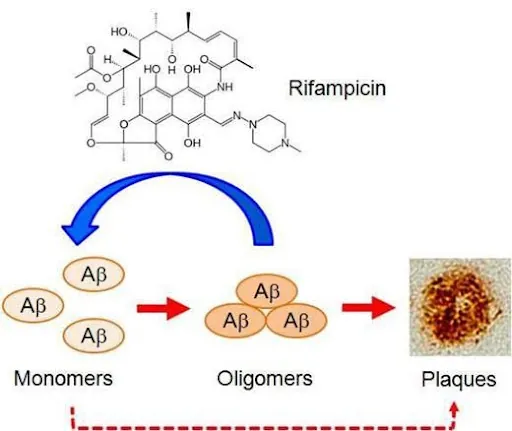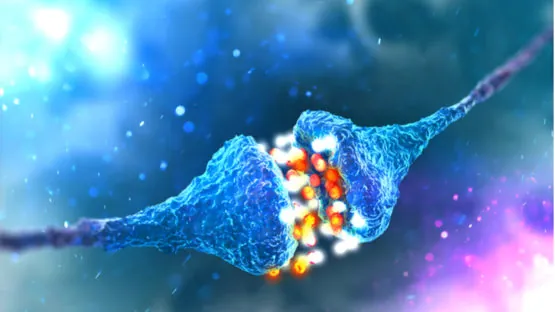Scientists have combined the popular antibiotic rifampicin with resveratrol to create a possible preventative treatment for age-related dementias [1].
Oligomers, not plaques?
Age-related dementias, such as Alzheimer’s disease, still defy current treatment options, impeding attempts to increase human lifespan. According to the theory of competing risks, we cannot hope to meaningfully increase lifespan until all lethal diseases of aging are addressed, because if an elderly person escapes one age-related disease, such as cancer, that person will soon succumb to another disease, such as dementia. This makes finding a cure for age-related dementias a pressing issue.
These diseases have something in common: their progress is linked to the accumulation of misfolded proteins in the brain, such as amyloid-beta (Aß), tau protein, and a-synuclein. This results in the formation of plaques and tangles that appear at the clinical stage of the disease. Yet, since attempts to clear those plaques have not led to meaningful alleviation of the symptoms, researchers are beginning to suspect that the treatment should begin much earlier, at the pre-clinical stage, and target the proteins’ oligomers [2].
Oligomers are polymers with just a few elements (“oligo” means “a few” in Greek). Amyloid oligomers are formed from single amyloid molecules (monomers) and serve as building blocks for the plaques, but they are also highly neurotoxic on their own. Moreover, amyloid oligomers are now believed to be prions [3] – misfolded proteins that can induce misfolding of other molecules of the same protein in what is known as prion infection.
Finding a partner
In 2016, these researchers had shown that a well-known antibiotic, rifampicin, can inhibit the oligomerization of Aß, tau, and a-synuclein in vitro and improve cognition in transgenic dementia-prone mice [4]. Unfortunately, rifampicin can be toxic, with side effects such as liver dysfunction and unwanted drug-drug interactions. Since administering brain-targeting drugs intranasally can enhance their performance and prevent damage to the liver, the researchers chose intranasal injection as the method of delivery in this new study.

Image from the authors’ 2016 paper: rifampicin prevents oligomerization and the formation of plaques
The main goal of the study was to test a possible combination treatment. The scientists searched for a compound that would be safe, counteract some of rifampicin’s toxicity, and preferably exert additional neuroprotective effects.
Screening for such a compound yielded a result that rings a bell for anyone in the longevity field: resveratrol. This geroprotective polyphenol possesses antioxidant, anti-inflammatory, and other beneficial qualities. Resveratrol also inhibits the expression of some harmful proteins that are upregulated by rifampicin, and it has considerable neuroprotective properties of its own. This led the researchers to expect that a combination of rifampicin and resveratrol could lower the toxicity and boost the overall effectiveness of the treatment.
Better together
The combination treatment was tested in various transgenic mouse models of dementia, starting when oligomer pathology and cognitive dysfunction were already detectable but still at a stage that “corresponded to the preclinical stage of neurodegenerative dementia in humans”.
Mice were divided into groups of around ten animals each that received either just rifampicin, just resveratrol, a combination, or a sham treatment. In two of the models, there were also groups that received either low- or high-dose combinations. Following one month of treatment, the cognitive function of the mice was assessed using the water maze test.
The results were encouraging and largely similar across the models. Both rifampicin and resveratrol showed neuroprotective effects, though not always statistically significant ones. As a rule, rifampicin was more effective than resveratrol. The combination treatment, however, either matched or surpassed the effect of rifampicin even at lower concentrations. This is important, since lower dosage means lower toxicity. This was confirmed by measuring liver function biomarkers (the combination treatment disrupted them significantly less). In some cases, the combination treatment was so effective in preventing oligomerization that the levels of harmful oligomers in the transgenic mice remained on par with their wild-type littermates. The cognitive function of these mice was greatly improved as well.
Interestingly, despite the cognitive improvement, there was no significant change in the abundance of amyloid plaques. According to the authors, this supports the hypothesis that anti-dementia treatments should target oligomers rather than plaques.
In the final section, the scientists outlined several criteria for effective preventive treatments of dementia. First, being long-term, such treatments should be safe and inexpensive. Second, they should be easily administered at home by the patients themselves. Finally, they should have a broad spectrum of action against various amyloidogenic oligomers (Aß, tau, and a-synuclein), because we cannot predict which type of dementia a patient will get. The authors suggest that their combination treatment answers all those criteria.
Conclusion
In a field where many pioneers have tried and failed, this study presents a fresh and clever concept of a preventative combination treatment against age-related dementias that targets oligomers rather than plaques. Among the study’s limitations are its relatively small size and the fact that the authors did not present a possible explanation for rifampicin’s neuroprotective qualities, so more research is needed to confirm the concept’s viability.
Literature
[1] Umeda, T., Sakai, A., Shigemori, K., Yokota, A., Kumagai, T., & Tomiyama, T. (2021). Oligomer-Targeting Prevention of Neurodegenerative Dementia by Intranasal Rifampicin and Resveratrol Combination–A Preclinical Study in Model Mice. Frontiers in Neuroscience, 15.
[2] Li, S., & Selkoe, D. J. (2020). A mechanistic hypothesis for the impairment of synaptic plasticity by soluble Aß oligomers from Alzheimer’s brain. Journal of neurochemistry, 154(6), 583-597.
[3] Rambaran, R. N., & Serpell, L. C. (2008). Amyloid fibrils: abnormal protein assembly. Prion, 2(3), 112-117.
[4] Umeda, T., Ono, K., Sakai, A., Yamashita, M., Mizuguchi, M., Klein, W. L., … & Tomiyama, T. (2016). Rifampicin is a candidate preventive medicine against amyloid-ß and tau oligomers. Brain, 139(5), 1568-1586.




